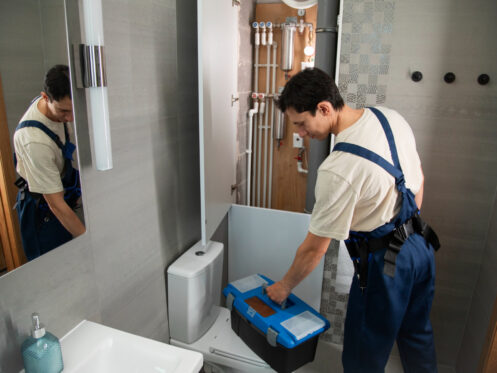When thinking about a bathroom plumbing remodel, upgrades often seem complicated and expensive. However, there are many easy and professional plumbing improvements that can make a big difference without a full overhaul.
Upgrading fixtures like faucets, showerheads, and adding efficient plumbing can improve both the look and function of your bathroom with minimal hassle. We want to help you make smart choices for your bathroom that don’t require tearing everything apart.
Some simple changes, like installing modern fixtures or improving water flow, provide lasting benefits. These upgrades can save water, enhance comfort, and bring a fresh, polished feel to your space.
By focusing on practical, manageable plumbing improvements, we can create a bathroom that feels both modern and reliable. In this article, you’ll learn how to plan and execute a bathroom plumbing remodel that improves function, efficiency, and long-term performance.
Let’s break down the key points you should consider:
- What a bathroom plumbing remodel really involves
- Choosing the right plumber for your remodel
- Understanding costs and what drives them
- How plumbing impacts your bathroom layout
- Making your bathroom remodel last
Keep reading, this guide will show how professional upgrades are easier than you might think and explain which changes deliver real value.
What a bathroom plumbing remodel really involves
A bathroom plumbing remodel includes more than swapping out old faucets or showerheads. It often means rethinking the whole system to improve how water flows and drains while making sure everything meets modern standards. This process touches on pipes, drains, and fixtures all working together smoothly.
Plumbing changes that go beyond just new fixtures
Changing fixtures like sinks, toilets, or tubs is just one part of the remodel. We also need to update the underlying plumbing to support new features. This might include moving water lines or drain pipes to fit a different layout or new products that use less water.
Additionally, upgrading valves, adding shut-offs, and replacing old connectors ensures safety and easier future repairs. Sometimes we add new vent pipes to prevent slow drainsor sewer smells. These changes help the whole system run better and last longer.
How bathroom remodel and plumbing projects work together
A bathroom remodel and plumbing work hand in hand. While the remodel focuses on design and style, plumbing ensures everything functions correctly behind the scenes. We start by planning the space, then figure out what plumbing changes are needed for new fixtures.
The process often begins with demolition to access pipes. Plumbers then install or move water supply lines and drains before new fixtures go in. Electrical and ventilation updates usually happen alongside to keep everything code-compliant.
Good timing and coordination between remodeling and plumbing tasks help avoid delays and reduce costs.
Updating pipes and drains for better long-term performance
Old pipes and drains often cause leaks, clogs, or slow drainage. Part of a bathroom plumbing remodel means assessing their condition and replacing worn-out sections. We use durable materials like copper or PEX pipingto improve water delivery and resist corrosion.
Drainpipes may need to be enlarged or rerouted to handle increased water flow from new fixtures. Proper slope and venting are checked to prevent backups and odors.
Upgrading pipes and drains now avoids future problems and saves money on repairs down the road. It also supports better water efficiency and complies with local building codes.
Choosing the right plumber for your remodel
Picking the right plumber is key to a smooth bathroom remodel. We need someone skilled in plumbing work, understands codes, and communicates clearly. This helps with timely project completion and avoids costly mistakes.
Why not every contractor handles plumbing remodels
Many contractors focus on general remodeling but don’t offer plumbing services. Plumbing requires specialized knowledge of water systems, local codes, and proper installation techniques. A plumber is trained to handle water lines, drains, and fixturehookups correctly.
Hiring someone without plumbing expertise can lead to leaks, code violations, or damage. It also risks delays since non-plumbers may call outside experts. For a bathroom remodel, we wanta professional who can manage plumbing and coordinate with other trades smoothly.
What to ask when hiring for a bathroom remodel with plumbing
We should ask several clear questions before hiring a plumber:
- Are you licensed and insured?
- Can you share examples of past bathroom remodels?
- How do you handle unexpected plumbing issues?
- What timeline do you provide for this type of work?
- How do you communicate progress or changes?
These questions reveal if the plumber is reliable and experienced with bathroom projects. Checking customer reviews adds confidence. Clear communication and planning help keep the remodel on track and within budget.
Splash Plumbing’s approach to bathroom upgrades
At Splash Plumbing, we focus on professionalism and quality. We make sure all plumbing work meets code and fits the bathroom’s design. Our team coordinates with contractors to avoid delays and reduce stress.
We prioritize transparent pricing and keep clients updated regularly. We also suggest water-saving fixtures and durable materials that improve both function and style. Our goal is to upgrade plumbing efficiently so homeowners enjoy lasting results without surprises.
Understanding costs and what drives them
We need to look closely at the real costs involved in a bathroom plumbing remodel. Knowing which parts of the job use the most money and what factors change the price helps us plan better and avoid surprises.
Can you remodel your bathroom plumbing for $10,000?
A $10,000 budget can cover many plumbing updates in a bathroom, but it depends on the project scope. Simple tasks like replacing fixtures, updating pipes in the same location, or installing a new shower valve usually fit this budget.
However, if we move plumbing lines or replace the water heater, costs can rise quickly. Labor is also a big factor. Hiring licensed plumbers for complex work adds to the price but ensures safety and code compliance.
To stick near $10,000, we should focus on:
- Replacing existing pipes without relocation
- Choosing mid-range fixtures
- Avoiding major structural changes
Setting aside about 20% extra for surprises, like hidden leaks, helps keep the budget under control.
What’s the most expensive part of the job and why?
Plumbing labor and major pipe upgrades often take the biggest share of the budget. Moving or adding plumbing lines means tearing into walls or floors, which increases labor time and material costs.
Replacing the water heater or installing new pipes with modern materials is costly because it requires skill and sometimes permits. If hidden damage or leaks appear once work starts, fixing these issues adds more cost.
Fixtures and accessories tend to be less expensive compared to labor and pipe replacement. Choosing affordable but reliable products helps save money.
We must also consider permits and inspections that both add to job cost but are necessary for safety and legality.
Factors that affect the total remodel cost
Several key factors change how much our remodel will cost:
- Bathroom size:Larger spaces need more pipes and materials.
- Fixture quality:High-end faucets and toilets raise costs.
- Age of existing plumbing:Old or damaged pipes may need full replacement.
- Scope of work:Simple upgrades are cheaper than relocating plumbing.
- Labor rates:Prices vary by region and complexity.
- Unexpected repairs:Hidden leaks or damage can increase the budget.
- Permits and inspections:Required in many areas, adding fees and time.
We should plan carefully. Mapping out exactly what we need helps control the bathroom remodel cost and avoid surprises.
How plumbing impacts your bathroom layout
Plumbing plays a major role in shaping how your bathroom is designed and functions. Moving fixtures like sinks, showers, and toilets requires careful planning to avoid costly problems. Proper drain and vent placement keeps everything working smoothly. The plumbing plan also affects how long the remodel will take and when certain tasks must happen.
Relocating sinks, showers, and toilets safely
When we want to move sinks, showers, or toilets, we must consider existing water supply lines and drains. Moving a toilet usually costs more because it requires relocating the main drain pipe, which is larger and often set in concrete or under the floor.
Relocating sinks or showers is generally easier but still needs correct water line adjustments and proper sealing to avoid leaks. We should have a professional assess if the location change might cause issues with water pressure or drainage.
Planning the new fixture placement with plumbing access in mind can save time and money. This reduces the risk of future leaks and drainage problems.
Drain and vent placement for efficiency
Drain placement is critical to keep wastewater flowing away quickly and prevent clogs. We need to make sure drains slope correctly, usually a 1/4 inch drop per foot, so water flows freely toward the mainsewer line.
Vents let air into the plumbing system to equalize pressure and help drains work properly. Without proper venting, drains can gurgle, and sewer gases may back up into the room.
Placing vents near drains and ensuring they connect to the main vent stack is essential. Poor venting leads to slow drainage and foul odors.
How plumbing plans shape the remodel timeline
A detailed plumbing plan helps us schedule the remodel efficiently. Rough-in plumbing, which includes installing pipes for water and drains behind walls or under floors, must finish before walls go up.
During the rough‑in phase, ensure your bathroom ventilation plan meets code standards—EPA recommends exhaust fans deliver at least 25 cfm continuously, or 50 cfm when turned on and off as needed, to control moisture and prevent mold or indoor air quality issues.
Installing fixtures comes after checking for leaks and ensuring proper water flow. Plumbing inspections often happen at key stages, which can affect timing.
Unexpected plumbing challenges, like accessing old pipes or fixing leaks, can delay the project. Having a clear plan helps minimize surprises and keeps the remodel on track.
Making your bathroom remodel last
To ensure your bathroom remodel stands the test of time, focusing on durable materials and regular upkeep is essential. Choosing smart, long-term plumbing upgrades helps avoid future problems and keeps your bathroom functioning smoothly for years.
Using quality plumbing materials for durability
We must start by selecting high-quality plumbing materials. Pipes made of copper or PEX offer better resistance to corrosion and temperature changes than older metal options. Copper is known for its reliability and can last over 50 years, while PEX is flexible, easy to install, and resistant to breaks.
Valves, fittings, and fixtures also matter. Brass or stainless steel components resist rust and wear better than cheaper plastics. Using these materials reduces leaks and the need for repairs.
Investing in durable materials upfront saves money and hassle down the line. It also supports a safer, more reliable plumbing system under the bathroom’s surface.
Maintenance tips post-remodel
After upgrading, keeping your plumbing in good shape requires regular care. One simple step is checking for small leaks around faucets, drains, and pipes every few months. Early repairs stop bigger damage later.
We should also clean drainsregularly to prevent clogs. Using a drain strainer helps catch hair and debris before they cause blockages. Avoid harsh chemical cleaners to protect your pipes.
Flushing your water heater and inspect valves yearly improves efficiency and extends its life. Paying attention to water pressure and unusual noises can alert us to problems early.
Routine maintenance protects our investment and helps the plumbing last longer without costly fixes.
Smart upgrades that future-proof your plumbing
Planning for the future means installing plumbing fixtures designed for efficiency and adaptability. Low-flow toilets and faucets reduce water use and lower utility bills. Installing these now meets modern standards and prepares us for stricter regulations.
According to ENERGY STAR,WaterSense showerheadscan save an average household approximately 2,700–2,900 gallons of water per year, along with around 330–370 kWh of energyannually thanks to reduced hot‑water use .
Choosing fixtures with easy-to-replace parts simplifies repairslater. Adding shut-off valves near sinks and toilets allows for faster repairs with less disruption.
We can also improve accessibility by considering ADA-compliant features, ensuring the bathroom remains functional for different needs.
Integrating smart water sensors detects leaks early, preventing water damage and saving money on repairs.
These smart upgrades build a plumbing system ready to handle tomorrow’s challenges without another major remodel.
Conclusion
We can improve our bathroom by making simple plumbing upgrades that last. Small changes like installing low-flow faucets or updating old pipes help save water and avoid future repairs.
Choosing professional services ensures the work meets modern standards for safety and efficiency. It also adds value to our home without too much hassle.
These choices make the bathroom more functional and easier to maintain. They also give the space a cleaner, updated look.
By focusing on both function and style, we create a bathroom we’ll enjoy every day. Smart plumbing upgrades help our remodel go smoothly and stand up to daily use.
Schedule your bathroom plumbing remodel with Splash Plumbingto ensure expert installation, code compliance, and lasting results.












